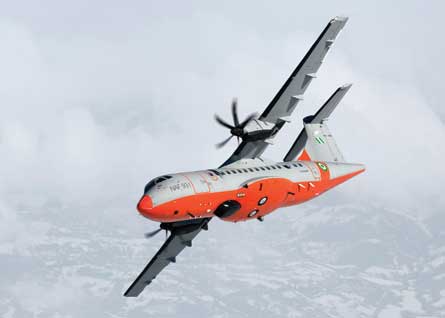For all the reasons turboprops are attractive as regional transports - versatility, fuel economy and good capability from short airfields - they have become increasingly attractive to military operators. One of the must-see aircraft at Le Bourget this week is the ATR 42MP Surveyor, an ad-hoc maritime patrol variant developed by Alenia Aeronautica from the ATR 42 regional turboprop made by Alenia Aeronautica-EADS joint venture ATR.
The aircraft is designed to minimise operating costs for maritime patrol roles, such as vessel search and identification, search and rescue (SAR), drug smuggling and piracy control, environmental control (pollution by oil and chemical substances), and patrol of offshore economic activities like fishing and oil exploration.
But a modular racking system makes the ATR 42MP a genuine multipurpose aircraft, enabling quick interior configuration changes to allow for carrying up to 48 passengers - in humanitarian evacuations, for example - or 36 equipped soldiers. Other configuration options accommodate as many as nine ATR standard cargo containers or 14 stretchers and two medical attendants. Yet another rearrangement allows for carriage and launch of up to 27 paratroops.
The aircraft can be equipped with a door openable in flight for SAR and air-drop of paratroopers, two bubble observation windows and two pylons on the fuselage sides, one for a search pod provided with light and flare launch and one for an additional pod, which in the case of Italy's customs police, the Guardia di Finanza, carries a half-inch machine gun. The ATR 42MP is intended for use in no- to low-risk environments.
 |
|---|
© Nigerian air force |
Turboprops are proving their worth in all sectors of the industry and are proving cost-effective in maritime patrol |
The ATR 42MP made its maiden flight in February 1999 and was given civil certification in October 1999 and the military qualification in February 2000. At the heart of the aircraft's surveillance mission is the Airborne Tactical Observation System, developed by Selex Galileo with Italy's Guardia di Finanza. The GdF operates four ATR 42MPs from its base at Pratica di Mare, on the Mediterranean coast near Rome.
With the GdF, the aircraft - supplemented by patrol variants of the Piaggio P180 Avanti II and other fixed- and rotary-wing assets, along with its surface fleet - has been a powerful weapon against crime in a region that is always been rife with smugglers and invaders. This year, in the seas around Italy's southernmost island of Lampedusa, which is closer to Tunisia than to Sicily, patrols monitoring the exodus of people fleeing turmoil in North Africa have located and rescued 20,000 people while arresting at least 42 human traffickers.
The Italian coastguard operates three ATR 42MPs, and another two are in service with the Nigerian air force, which took its second in March 2010. Libya's General Security Agency has one aircraft, delivered in September 2010, although this one may not be operating under the conditions currently prevailing in that region.
Nigeria's two aircraft are undergoing re-fits with a ku-band satellite communication system, with work expected to be completed in July and November 2011.
 |
|---|
ATR sees market opportunities for its maritime patrol aircraft in Algeria, Bangladesh, China, Greece, India, Indonesia, Japan, Malaysia, Morocco, Oman, Pakistan, Panama, the Philippines and Trinidad & Tobago.
Additional capabilities are available in a similar variant of the stretched aircraft, the ATR 72 MPA, or even anti-submarine warfare capabilities in the ASW version.
Along with the ATR 42 MP modular interior mission system and onboard equipment, the ATR 72ASW variant of the turboprop features a rotary sonobuoy launcher and magnetic anomaly detector system, chaff and flare for passive defence, and an armaments launch system for torpedoes, anti-skip missiles and depth charges.
Nigerian air force
The ATR 42MP is designed to minimise operating costs for maritime patrol
Source: Flight Daily News
















